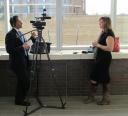My favorite photo of the day Natalie was born ten years ago. It looks like she’s smiling at her dad!
This is my tenth year owning my own PR firm. You learn working in PR that no one “in the biz” really celebrates anniversaries. I would have trouble even remembering the date except for one very significant reminder. I started my business just a few months before my daughter was born. So big and pregnant… I opened my laptop, cell phone in hand, on the couch of my parent’s house and started a PR consultancy company. We had just moved to town from Scottsdale and hadn’t even bought a house yet. This probably isn’t exactly part of the ideal business plan when you go to the SBA or the Kauffman Foundation’s entrepreneurship program. But it worked for me.
Like with a lot of small businesses, it takes time to work through the first few years. Things like: learning the art of prioritization and delegation; how to say no; do I REALLY have to file taxes EVERY year; and so on.
In addition to the tedious things every new business owner has to learn about taxes and technology, I’ve put together a list of “First Decade New Business Lessons Learned” by Megan Neher. I plan to read this 10 years from today and get a good laugh. Hopefully I’ll have a whole new list of new lessons learned by then!
1. FIO. Anyone who knows me will understand this acronym. I had hoped it would catch on like LOL or OMG. It stands for “Figure It Out,” and it’s something I tell every new intern or college student I’m advising. I think back to when I started as a newspaper reporter. At 23 years old, driving around the city with a folded paper map, not a GPS, figuring out how to get from one place to the next without Google. I had a written calendar, no cell phone and did research the old fashioned way. I’m not suggesting we go back to that; I just think we need to allow people to figure things out on their own.
2. Breathe. This lesson took me nearly ten years to learn. It’s basically my way of saying “don’t sweat the small stuff.” As I look around at clients and colleagues, I’m observing similar professionals my age going through the same growing pains. I guess this is something we all do! Start out rigid, and as we grow and mature in our professions, we become more flexible. We begin to understand that it is the gray area where progress happens.
3. My bra is not the only support I need! I’ve enjoyed being a part of KC/IABC but especially the entrepreneurs (support) group now called independent communicators. We meet monthly to talk about a variety of topics including things like clients, taxes, technology, websites, workload and more. It’s been my best support group, my best resources for subcontractors and a wonderful place to meet friends.
4. Don’t underestimate follow-up. This has become my secret to maintaining happy clients. (don’t tell my competitors!)
5. Mistakes aren’t for newbies… unfortunately. I wanted to get my mistakes out of the way early on and be done with them, but guess what? I’m still making them, and I’ve come to the realization that learning lessons the hard way is sometimes the only way we’ll learn.
6. Faith. I have a unrelenting faith in people. I can’t get rid of it. I am a terrible judge of character and instead of becoming a skeptic, I’ve decided to embrace it and continue to believe in people even when they let me down. I’m constantly surprised by them when they disappoint me, but at least I’m optimistic. And, by the grace of God, I haven’t been hurt by anyone too terribly bad, so perhaps my faith in people isn’t misplaced after all!
7. Home sweet home. As much as I’d like to be “more professional” with a real office, receptionist, fake plant, logo hanging on the wall… all of those things will never outweigh the ease of having a home office. I can roll out of bed, make coffee in my slippers and get two hours of work done before 8 a.m. or squeeze in three hours of work after the kids go to bed. (Of course the home office challenges my work-life balance from time to time, but it’s been remarkable how clients and others have understood kids and dogs in the office!)
8. Solitary confinement. I can’t do this job alone, nor do I want to. I loved working at the advertising agency in Arizona because of the close friendships I made. I quickly turned my “sole proprietorship” into a boutique PR shop so I could bring in some seasoned experts to learn from, share ideas and collaborate. I wouldn’t have it any other way. Ashley Cleveland has worked with me for about seven years and she’s been a gift from heaven. I’ve partnered with other colleagues along the way too, including Nancy Besa. We share a lot of laughs as well as ideas!
So those are some of the lessons I’ve learned. And, trust me… there are many, many others.
After 10 years, what do the next 10 years have in store – who knows? More figuring it out; mistakes and faith! I do hope to breathe a little more and maybe even change the company’s name. What a boring name! Got any ideas?




